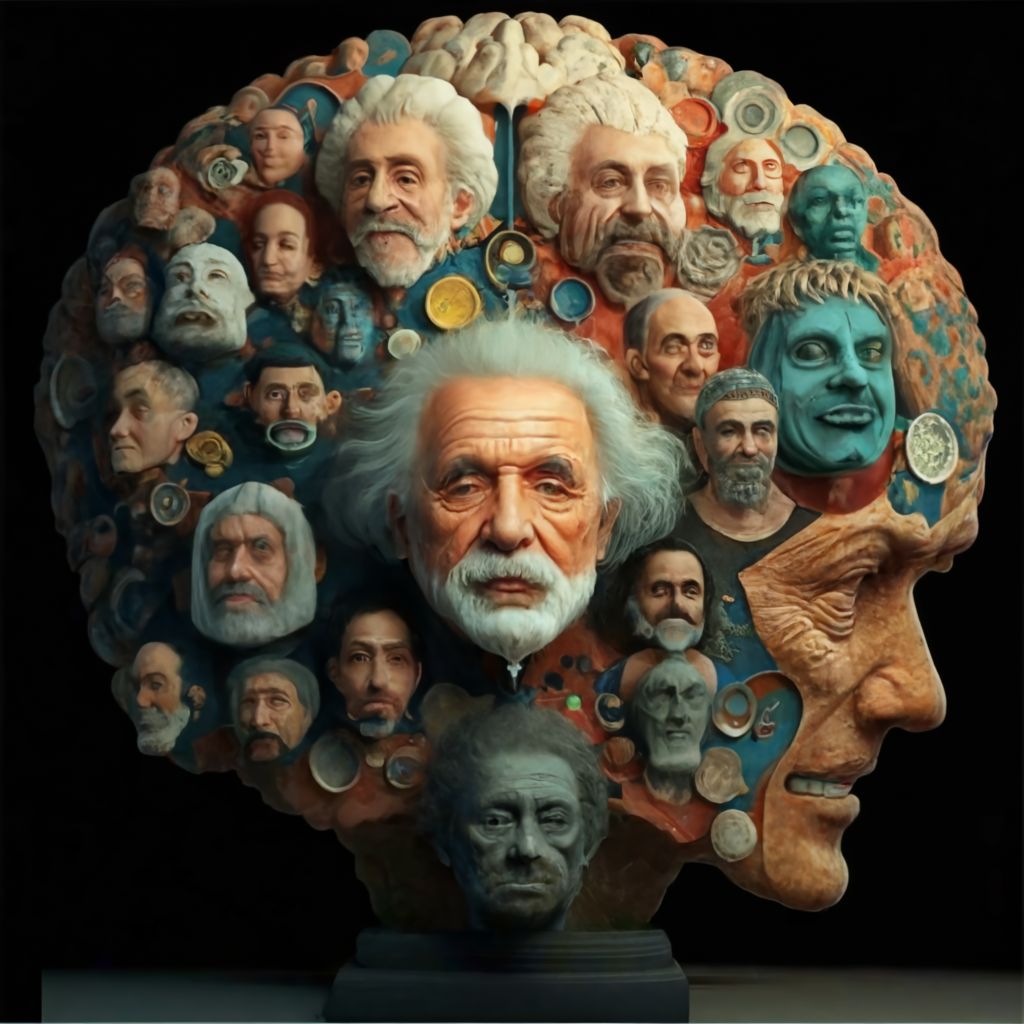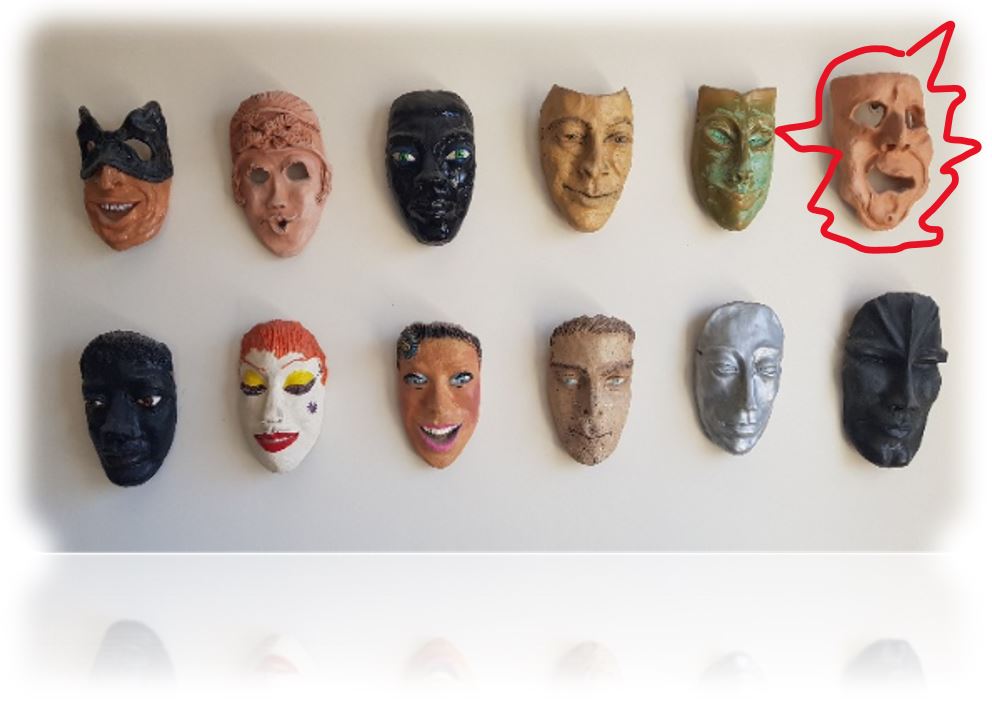Archive
You are currently browsing the archives for the Shared blog category.
By Prof. Levine & Dr. Salganik
In our model, the self includes most of the components of the human soul. The model distinguishes between the "primary self", or the "initial self" which is in fact the basic biological core consisting of a number of innate structures and subject to increasing development during life, this self includes the instinctive emotional and cognitive parts of the person. The exact structure of the primary self and the relationships between its parts still require clarification [see previous conversations]. The primary self uses the memory stores and the abilities of cognition, emotion and more.
On the other hand, the "social self" [consisting of "secondary selves"] is built throughout life, and represents an epistructure that gradually develops from the primary self during the person's exposure to social influence, and consists of the internalization of figures significant to the person, originating from external groups or even imaginary groups (related , for example, to a story, a myth, a movie, etc.) which greatly influenced the person.
It is possible that this social self will also include the personification of objects and agencies most important to a person. We note here that only parts of the self are conscious, while other parts are not. Usually the person is not aware of the fact that the social self consists of influential internalized characters that dictate his attitudes and behavior and recognizes these as arising from his own will.
Below we will discuss the structure of the social self: it consists of "secondary selves" which include the following types: 1) the variety of representations of the "Me" that originate from attitudes and feelings towards the self and its representations at different periods in life 2] representations of internalized figures that originate from the significant figures that the person is exposed to during his life , but as mentioned there may also be imaginary characters represented in books, movies, etc. that had a great impact on the person. 3] internalized representations of "subculture" [subculture refers to social influences in the environment in which a person lives and are not necessarily related to a specific person].

AI-assisted illustration: The Board of Internalized Characters. The large figure expresses the internalized dictator-self
We refer to the social self metaphorically as the "directorate of characters" or more precisely the "directorate of internalized characters." We note that in this internalized board of directors there is usually a hierarchy in which there are more influential and dominant figures that we metaphorically called the "dictator-self or selves" and these figures set the tone and even censor and determine which content, attitudes and behaviors can be included in the board of directors. As mentioned, we will point out again that the person as a whole is not usually aware of the influence of the internalized character board and recognizes its influence as arising from his own desires and attitudes.
We will also note that, as a general rule, the board of directors is very dynamic and there are constant struggles and power relations between the internalized characters that make it up regarding the positions they will express, with the dictator-self or -selves usually dictating the tone.
This is how you can internalize various external characters that influence the person in the "directory of internalized characters", but we will emphasize again that usually the most important internalization is that of what we called the "dictator-self". Here it is about internalizing a character that has a great influence and shapes the person for good and/or bad, that has a great influence on the panel of internal characters that build the social self.
The dictator-self’s attitudes play a central role in making decisions about internalizing information and characters. He decides whether to reject the internalization or, if accepted, in what form it will be internalized. In other words, in a sense, we assume that this influential figure is also a form of internal censorship.
It should be emphasized that these are not concrete hypotheses regarding the presence of internalized figures in the inner world of the individual as a sort of "little people inside the brain", but rather in their representation in different brain areas whose nature and manner of representation still requires further research.
We will also note that although we call this character a "dictator", with the exception of a certain type, its characteristics are not the same as those of a dictatorial ruler in a certain country, but rather that this character is dominant and influential among the "characters’ board".
This model therefore holds that the social self consists of "internalized key figures [usually human], usually referring to the significant people in a person's life who have played a central role in shaping the individual's beliefs, values and self-concept. These figures may include family members, friends, mentors , teachers or any other influential person who left a lasting impression on the person. Sometimes, these will also include historical, literary and other figures who left a noticeable mark on the person and were internalized by him.
The term "internalized" implies that the influence of these key figures has been absorbed and integrated into the individual's thoughts, attitudes, and behaviors. This internalization occurs through the process of observing, interacting with, and learning from these important people. As a result, the individual may adopt certain values, perspectives, and approaches to life that reflect those of the influential figures.
These internalized figures can serve as guiding forces in decision-making, moral thinking and emotional regulation. Positive influences can contribute to a person's well-being, security and resilience, while negative influences can lead to internal conflicts or challenges in personal development.
Read more »
By Prof. Levine & Dr. Salganik
Greetings,
Attitudes affect the way we perceive and respond to the world around us. Attitudes can influence our decisions, actions, preferences, and evaluations.
Attitudes are created through a complex interplay of various factors, including:
Socialization: Attitudes are often shaped during the socialization process, which occurs mainly in childhood and adolescence. Family members, peers, teachers, and significant others influence the development of attitudes through direct instruction, observation, and reinforcement.
Cognitive processes: Attitudes can be formed through cognitive processes such as reasoning, evaluation and judgment. People may develop attitudes based on beliefs, values, and interpretations of information.
Personal experiences: Personal experiences play a significant role in shaping attitudes. Positive or negative experiences with certain objects, people or situations can influence the formation of attitudes towards them.
Media and Communication: Mass media, including television, movies, the Internet, and social media platforms, can shape attitudes by exposing people to certain ideas, values, and perspectives.
Cultural and social influences: cultural norms, traditions and social expectations contribute to the formation of attitudes. People often adopt attitudes that are consistent with the values and beliefs of their culture or social group.
Emotional reactions: emotional reactions to stimuli can also affect the formation of attitudes. People may develop positive or negative attitudes based on their emotional responses to specific objects, people, or situations.
Personal characteristics: individual differences, such as personality traits, self-esteem, and cognitive abilities, can influence the formation of attitudes. For example, people with high levels of openness to experience may be more open to forming new attitudes, while those with low self-esteem may be more resistant to attitude change.
In general, attitudes are dynamic and can evolve over time in response to new information, experiences, and social influences. In addition, attitudes can vary in strength and stability, from fleeting opinions to deeply held beliefs.
Read more »
By Prof. Levine & Dr. Salganik
Hello to our readers,
The evolution of religion in human society is a complex and multifaceted phenomenon that has been studied by researchers from various disciplines including anthropology, sociology, psychology and history. Although it is challenging to trace exact origins and trace a linear progression, there are a few key stages and developments that can be seen in the evolution of religion [Written with the help of the GPT CHAT after we checked and made many edits and additions to the text]:
1. Animism and Shamanism: Animism is often considered one of the earliest forms of religious belief, where people attribute spiritual meaning to natural elements such as animals, plants, rivers and mountains. In animistic societies, there is a strong emphasis on the interconnectedness of all living things and the natural world.
Shamanism, which probably arose within animistic cultures, includes the belief in spiritual beings or forces and the practice of shamanic rituals by people who believe they have special powers to communicate with these spirits or to cross between the physical and spiritual realms.
2. Polytheism: Polytheistic religions developed as human societies became more complex and organized. These religions include multiple gods and goddesses, each associated with specific areas such as fertility, war, agriculture, or the arts.
Polytheistic belief systems often include complex mythologies and rituals aimed at propitiating or honoring various deities. Examples include the pantheon of ancient Egypt, Greece, Rome, Mesopotamia and the Norse gods of Scandinavia.
3. Monotheism: Monotheistic religions center around the worship of a single supreme god. This development represents a significant change from polytheism and is often associated with the emergence of ethical monotheism, which emphasizes moral codes and the relationship between humans and the divine.
Judaism, founded by the Hebrew people, is one of the earliest monotheistic religions, with the belief in Jehovah as the one true God. Christianity grew out of Judaism, when the teachings of Jesus Messiah emphasized monotheism and love for God and humanity. Islam, founded by the Prophet Muhammad in the 7th century AD, also promotes monotheism, where Allah is the only God.

AI-assisted visualization
4. Organized religion: As societies became more complex, religious practices became institutionalized, leading to the formation of organized religions with established hierarchies, priests, and religious laws. These institutions played crucial roles in shaping cultural identity, social norms and governance.
For example, in medieval Europe, the Catholic Church held significant power and influence over both religious and secular matters, and played a central role in the lives of individuals and communities. Similarly, in ancient India, Hinduism developed into an organized religion with complex rituals, caste systems, and philosophical schools.
5. Secularization and rationalization: The process of secularization refers to the decline in the influence of religion in public life and the rise of secular institutions and ideologies. This phenomenon gained momentum during the Enlightenment in Europe, when thinkers advocated reason, science and individual freedom over traditional religious authority.
Rationalism and scientific inquiry challenged religious dogma and superstitions, and led to the separation of religion from the state in many societies. However, religion continues to be a significant force in the lives of individuals and communities, and the relationship between religion and secularism remains complex and multifaceted.
6. Globalization and syncretism: Globalization has enabled the exchange of ideas, including religious beliefs and practices, which has led to increased syncretism [a process of settlement and unification between different faiths] and the merging of different religious traditions. This phenomenon is particularly noticeable in areas with diverse cultural and religious landscapes, where people combine elements from multiple religions in their religious practices.
Examples include the syncretic religions of the Caribbean, such as Voodoo and Santeria, which combine African, indigenous and Christian elements. Globalization has also led to the spread of the world's major religions to new regions, resulting in the adaptation and hybridization of religious traditions.


AI-assisted visualization
Read more »
By Prof. Levine & Dr. Salganik
Greetings,
We will first distinguish between civilization on the one hand and empires and states on the other. According to Samuel Huntington [author of the book "The Clash of Civilizations,"] "Civilization is the broadest cultural entity. Civilization is the highest degree of human identity that distinguishes different groups of people. As history shows us, he believes, civilizations are "a superpower "In history that survives the many upheavals that cultures, peoples and countries can go through – ideological, behavioral, governmental, etc. Civilizations differ from each other in their basic values and basic views and assumptions in a variety of questions and ideas [see Wikipedia].
An empire, on the other hand, is defined as a political sovereignty, for example a state, which controls large areas inhabited by populations that differ ethnically and culturally from its ruling center [see Wikipedia]
In this blog we will discuss the rise and especially the fall of empires and states and we will also try to examine this through the lens of the board of internalized figures in the individual building his social self and the dominant figures in this board.

Let's first mention, as in any conversation, the model we propose for "self". First we note that in our model the self includes most of the components of the human soul. The model distinguishes between the "primary self", or the "initial self" which is in fact the basic biological nucleus consisting of a number of innate structures and subject to increasing development during life, this self includes the emotional and cognitive instinctive parts of the person. The exact structure of the primary self and the relationship between its parts still requires clarification [see previous conversations].
The primary self is using the memory stores and abilities of cognition, emotion and more. On another hand, "social self" [consisting of "secondary selves"] is being built during the whole life, and represents an epistructure that develops during the exposure of the person for social influence, and consists of the internalization of figures significant to the person, originating from external groups or even imaginary groups (related, for example, to a story, myth, film, etc.) that greatly influenced the person. It is possible that it can also include the personification of objects and agencies that are extremely important to a person.
Read more »
By Prof. Levine & Dr. Salganik
Greetings
Below we will detail the model we propose for "Self". First we note that in our model the self includes most of the components of the human soul. The model distinguishes between the "primary self", or the "initial self" which is in fact the basic biological core consisting of a number of innate structures and subject to further development during life, this self includes the emotional and cognitive instinctive parts of the person. A special structure whose characteristics are fed by the cognitive and emotional parts of the primary self is that of the six "channels of sensitivity" of the individual that are related to: status, norms, attachment to others, threat, routine, and energy level. The exact structure of the primary self and the relationship between its parts still requires clarification and it seems that the channels of sensitivity are structures whose instinctive emotional and cognitive characteristics and more are found in the reserves of the primary self.
Based on the structures of the primary self, using its memory stores and abilities, cognition, emotion and more, develops an epistructure of the "social self" [consisting of "secondary selves"], which is a structure that develops during the person's exposure to social influence, and consists of the internalization of characters that are significant to a person, originating from external groups or imaginary groups (related, for example, to a story, myth, movie, etc.) that greatly influenced the person. It is possible that it can also include the personification of objects and agencies that are extremely important to a person.
We will note here that parts of the self are conscious while other parts can be unconscious.
Read more »
By Prof. Levine & Dr. Salganik
Greetings to our readers.
First we will again define what internalized figures are: internalized key figures [usually human], usually refer to the significant people in a person's life who have played major roles in shaping the individual's beliefs, values, and self-concept. These figures may include family members, friends, mentors, teachers, or any other influential person who has left a lasting impact on the person's psyche. Sometimes, these will also include historical, literary, and other figures that left a noticeable mark on the person and were internalized by him.
The term "internalized" implies that the influence of these key figures has been absorbed and integrated into the individual's thoughts, attitudes, and behaviors. This internalization occurs through the process of observing, interacting with, and learning from these important people. As a result, the individual may adopt certain values, perspectives, and ways of approaching life that reflect those of the influential figures.

These internalized figures can serve as guiding forces in decision-making, moral thinking and emotional regulation. Positive influences can contribute to a person's well-being, security and resilience, while negative influences can lead to internal conflicts or challenges in personal development.
Recognizing and understanding the influence of internalized human key figures is essential to self-awareness and personal growth. It allows people to evaluate the values they hold, question assumptions and make deliberate decisions about the kind of person they want to be. In addition, the awareness of these internalized influences can contribute to building healthier relationships and fostering positive connections with others.
Below, we will mention again the model we propose for "self":
Read more »
By Prof. Levine & Dr. Salganik
Greetings,
In this comprehensive conversation we will discuss the question of why characters in general and internalized characters in particular are such an important element in the construction of the social self.
Let us first define the self,
The self is the agent or subjective inner center that we identify as ourselves, which represents the "Me" of each of us, and we usually have a sense of its continuity throughout our lives, although some argue that the experience of the continuity of the self differs between different individuals. Although on the one hand everyone has an experience of self, on the other hand quite a few authors claim that the experience of self is a kind of illusion and that many brain processes are involved in our mental life and the self and its functions.

Aharon Saloman [1936- ]
Aaron Saloman suggested that words like self, himself, etc. do not refer to a special kind of entity, but provide powerful syntactic mechanisms for constructing utterances that repeatedly refer to the same thing without tiresome and vague repetition of other referring names or phrases. Others claim that the experience of the self is so intimate and immediately familiar to each of us that the existence of the self cannot be doubted. Kant spoke of the self as a kind of agent that organizes the life of the soul. Philosopher Daniel Dennett defined the self as the "narrative center of gravity". This definition embodies within it the perception of the self both as the center of the experience, and as one that is in a broader and more continuous narrative.

Daniel Dennett [ 1942- ]
The spiritual goal of many approaches and traditions from the East involves the dissolution of the ego, in contrast to the essential self, which in their perception is permanent and conscious, does not require any additional evidence, and it is this that illuminates the activities of recognition [in the sense of CONCIOUSNESS, and enables one to reach self-recognition [in the sense of understanding, perception, etc.] through appropriate practice of man's true nature, an experience or phenomenon known variously as enlightenment, nirvana, presence, and the "here and now" experience.
"Self" also has a significant social aspect since we humans live within a social matrix. Martin Buber, the philosopher claimed that there is no self without you, meaning the other, and the relationship with him defines the self. The question then arises, what is that social self? We believe that the "social self" is a collection of internalized characters with their perceptions, feelings, attitudes and characteristics, where we will elaborate more on this topic later.
Let's now define what internalized characters are:
key figures [usually human], internalized in a person's life, usually refer to the significant people who have played major roles in shaping the individual's beliefs, values, and self-concept. These figures may include family members, friends, mentors, teachers, or any other influential person who has left a lasting impression on the person's psyche. Sometimes these will also include historical, literary, and other figures that left a noticeable mark on the person and were internalized by him.
The term "internalized" implies that the influence of these key figures has been absorbed and integrated into the individual's thoughts, attitudes, and behaviors. This internalization occurs through the process of observing, interacting with, and learning from these important people. As a result, the individual may adopt certain values, perspectives, and ways of approaching life that reflect those of the influential figures.
These internalized figures can serve as guiding forces in decision-making, moral thinking and emotional regulation. Positive influences can contribute to a person's well-being, security and resilience, while negative influences can lead to internal conflicts or challenges in personal development.
Recognizing and understanding the influence of internalized human key figures is essential to self-awareness and personal growth. It allows people to evaluate the values they hold, question assumptions and make deliberate decisions about the kind of person they want to be. In addition, the awareness of these internalized influences can contribute to building healthier relationships and fostering positive relationships with others.
Read more »
By Prof. Levine & Dr. Salganik
Hello to our readers,
The current article is aimed more at mental health professionals but may also be of interest to those who are not therapists and are interested in the issues of mental health care. As we mentioned in previous conversations, we also hold that within us, in our minds, the social "self" is represented by a kind of "jury" or "board" of internalized characters [which for short we will call a board of directors].
The "secondary self" contained in the "social self" includes: 1] the variety of representations of the "self" that originate from attitudes and feelings towards the self and its representations in different periods of life 2] representations of internalized figures that often originate from significant figures that the person is exposed to during his life, but as mentioned may also be imaginary characters represented in books, movies, etc. that have greatly influenced the person. 3] internalized representations of "subculture" [subculture refers to social influences in the environment in which the person lives and are not necessarily related to a particular person]. We call the social self metaphorically "the directorate of the characters" or more precisely the "directorate of the internalized characters". We note that, as we mentioned before, this board usually has a hierarchy in which there are more influential and dominant characters that we metaphorically called "the dictator self or selves" and these set the tone and even censor which content, attitudes and behaviors cannot be included in the board of characters. We note that the person as a whole is not aware of the influence of the character board and recognizes the influence as arising from himself and his will and attitudes. We will also note that, as a general rule, the board is very dynamic and there are constant struggles and power relations between the internalized characters that make it up over the positions that will be expressed when the internal dictator or dictators dictate the tone.
This is how it is possible to internalize various external figures that influence the person, but we emphasize that usually the most important internal internalization is that of what we will call the internal "dictator self". Here it is about internalizing a character that has a great influence and shapes the person for good and/or bad, that has a great influence on the board of internal characters that build the social "self". To this internal dictator we assume a decisive role and a profound influence on the internalization of external figures [or in professional parlance external objects]. The dictator's positions (attitudes) play a central role in making decisions about character internalizations. He decides whether the internalization should be rejected or, if accepted, in what form it will be internalized.
In other words, in a certain sense, we assume that this influential figure is also a kind of internal censor. It should be emphasized that we are not talking or conjecturing concretely about the presence of figures in the inner world as a sort of “little people”, kind of mental homunculus, but in their representations whose nature and manner of representation in the brain still requires research. We will also note that although we call this character "dictator", except for a certain type, his characteristics are not the same as that of a dictatorial ruler of a certain country, but rather that this character is dominant and influential among the "Directorate of Characters".
![Illustration: The board of internalized characters and the internalized dictator self [courtesy of Sarit Shimshoni] Illustration: The board of internalized characters and the internalized dictator self [courtesy of Sarit Shimshoni]](data:image/svg+xml,%3Csvg%20xmlns='http://www.w3.org/2000/svg'%20viewBox='0%200%20797%20534'%3E%3C/svg%3E)
Illustration: The board of internalized characters and the internalized dictator self [Courtesy of Sarit Shimshoni].
We claim that the therapist has to adapt the character that he will represent and that will be reflected in the therapy, so that it will be internalized by the patient and will have a positive effect on his board of characters and especially on patient’s dictator self. This featured character should be accepted by the censor of the internal dictator and gradually acquire an increasing place in the hierarchy of characters on the board. In order for this to happen, the therapist has to treat the dictatorial figure (figures) with respect, and learn to contain them. We note that this step is extremely important for the success of the treatment.
On the other hand, the therapist has to find ways that will be accepted by the dictatorial figure and soften its effects [in a meaning that it will undergo a certain change] while presenting and demonstrating a figure that will be accepted by the board of directors and during the treatment will even rise in the hierarchy of figures and its influence will increase, and it is possible that at a certain stage it will even gradually become the most influential figure. We emphasize that the character the therapist presents to the patient is usually not his own character he represents in his daily life, but as mentioned one that fits the structure of the patient's board of directors. Although it could be mentioned that this requires the therapist to lose his authenticity, we’d like to note that training therapists for desired behaviors has long been practiced in a variety of therapeutic methods.
For example, this is how psychoanalytic therapists learn to be attentive, to demonstrate neutrality towards their patients, while cognitive therapists learn to adopt Socratic approaches and ask questions that lead their patients to see and notice alternatives to their usual thinking. Supportive therapists, on the other hand, learn to encourage, demonstrate the positive aspects and give advice to their patients, while Rogerian therapists learn to reflect the words and behavior characteristics to their patients. The difference between our approach and these approaches is that we require the therapist not to adopt one particular approach which he will project and behave towards his patients, but rather be versatile and change the characteristics of his behavior and treatment of his patients according to the needs of the inner dictator and their board of characters.
Read more »
By Prof. Levine & Dr. Salganik
Greetings,
Let us first mention again that in the model we propose for the "self", one must first differentiate between the primary self, which is actually the basic biological nucleus consisting of several innate structures and which is subject to development during life. and the "social self" [consisting of "secondary selves"], which is a structure that develops during a person's exposure to social influence, and consists of internalizations of figures significant to a person, originating either from external groups or from imaginary groups (related, for example, in the form of a story, from a myth, from a movie, etc.) that were having a considerable effect on the person). The "secondary selves" included in the "social self" include 1] the variety of representations of the "Me" that originate from attitudes and feelings towards the self and its representations in different periods of life 2] the representations of internalized figures that often originate from significant figures that the person is exposed to during his life but as mentioned may also be imaginary characters represented in books, films, etc. that have had a considerable influence on man. 3] internalized representations of the "subculture" [subculture refers to social influences in the milieu [environment] in which the person lives and are not necessarily related to a specific person].

The board of characters and the internal dictator: Photograph in courtesy of Shimshoni Sarit
We call the social self metaphorically the "directorate of characters" or more specifically the "directorate of internalized characters." We note that, as we mentioned before, in this board there is usually a hierarchy in which there are more influential and dominant figures that we metaphorically called "the tyrant or internal tyrants" and these set the tone and even censor what content, attitudes and behaviors cannot be contained in the board of figures.
We note that the person as a whole is not aware of the influence of the board of characters and recognizes the influence as coming from himself and his own will and positions. We will also note that, as a rule, the board of directors is very dynamic and there are constant struggles and power relations between the internalized characters that make it up on the positions that will be expressed when the internal dictator or dictators dictate the tone.
We will now ask what happens in communication between two people in general and between spouses in particular?
Read more »
By Prof. Levine & Dr. Salganik
Greetings,
Let us recall first that in the model we propose for the "self", one must first differentiate between the primary self, which is actually the basic biological core consisting of a number of innate structures and which is subject to development during life. and the "social self" [consisting of "secondary selves"], which is a structure that develops during a person's exposure to social influence, and consists of internalizations of figures significant to a person, originating either from external groups or from imaginary groups (related, for example, in the form of a story, from a myth, from a movie, etc.) that were having a considerable effect on the person). The "secondary selves" included in the "social self" include 1] the variety of representations of the "Me" that originate from attitudes and feelings towards the self and its representations in different periods of life 2] the representations of internalized figures that often originate from significant figures that the person is exposed to during his life but as mentioned may also be imaginary characters represented in books, films, etc. that have had a considerable influence on man. 3] internalized representations of the "subculture" [subculture refers to social influences in the milieu [environment] in which the person lives and are not necessarily related to a specific person].

Board of Directors: Photographed in courtesy of Shimshony Sarit
We call the social self metaphorically the "directory of characters" or more specifically the "directory of internalized characters." We note that, as we mentioned before, in this board there is usually a hierarchy in which there are more influential and dominant figures that we metaphorically called "Dictator Self or Selves) or the internalized dictators" and these set the tone and even impose censorship on content, attitudes and behaviors that cannot be contained in the board of figures. We note that the person as a whole is not aware of the influence of the board of characters and recognizes the influence as coming from from himself and his own will and positions.
We will also note that as a rule the board of characters is very dynamic and there are constant struggles and power relations between the introverted characters that make it up over the positions that will be expressed when the internal dictator or dictators dictate the tone. Finally, we assume the existence of another internalized group that we will call the enemy group, the individuals represented in it are seen as enemies and the internal dictator imposes censorship on their inclusion in the board of directors.
The question arises as to whether in certain animals there is a minimal, partial, and perhaps more than that representation of such an internalized board of directors of members of their species and what are its characteristics?
Read more »

 Prof. Joseph Levine, M.D. is an emeritus associate professor in the Division of Psychiatry, Faculty of Health Sciences, Ben Gurion University in Israel. Prof. Levine is a certified psychiatrist with clinical experience in controlled trials of adult psychiatric disorders and in psychotherapy. He was awarded a NRSAD independent investigator grant for the study of Creatine Monohydrate in psychiatric disorders -- mainly Schizophrenia. He resides and treats patients in Tel Aviv and all of central Israel.
Prof. Joseph Levine, M.D. is an emeritus associate professor in the Division of Psychiatry, Faculty of Health Sciences, Ben Gurion University in Israel. Prof. Levine is a certified psychiatrist with clinical experience in controlled trials of adult psychiatric disorders and in psychotherapy. He was awarded a NRSAD independent investigator grant for the study of Creatine Monohydrate in psychiatric disorders -- mainly Schizophrenia. He resides and treats patients in Tel Aviv and all of central Israel.







![Illustration: The board of internalized characters and the internalized dictator self [courtesy of Sarit Shimshoni] Illustration: The board of internalized characters and the internalized dictator self [courtesy of Sarit Shimshoni]](https://joseph-levine.co.il/wp-content/uploads/2024/02/directoriate.jpg)

